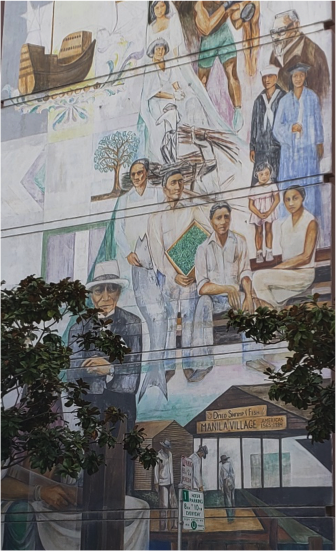By: Rosie Abriam, Co-Chair, AAPIP-Metro DC Chapter; COO, The Leader Project (HI/DC)
Photos courtesy of Kathy Mouacheupao, Co-Chair, AAPIP-Minnesota Chapter; Executive Director, Metropolitan Regional Arts Council
Community Redevelopment and Philanthropy are words/sectors rarely seen in the same article let alone in the same sentence! During the 2018 National AAPIP Convening – these two worlds were uplifted and brought historical relevance to current issues. The community tour hosted by Chinatown Community Development Center (CCDC), SOMA Pilipinas and Bindlestiff Studio provided an in-depth perspective of two historic neighborhoods in San Francisco – Chinatown and the South of Market (SOMA) Filipino Cultural Heritage District.
The tour began with lunch and a panel discussion in Chinatown led by Erika Gee, Senior Planner of Chinatown Community Development Center (CCDC). Speakers included CCDC Community Planning Manager Roy Chan, San Francisco Office of the Mayor Deputy Chief of Staff for Education and Equity Hydra Mendoza, The Kresge Foundation Arts and Culture Program Officer Michelle Johnson, and SoMa Pilipinas Project Manager Raquel Redondiez. They provided historical reference and stories which wove wins as a result of community involvement as well as painful lessons learned. They laid the foundation for what was to come in our walking and bus tours.
Outside the restaurant we began our walking tour of Chinatown. First stop was the Ping Yuen public housing development. Completed in 1955, the original funding for Ping Yuen was in large part secured by Eleanor Roosevelt’s effort and appeal to her husband for public housing in the San Francisco Chinatown neighborhood. In 2014, HUD transferred this housing project to Chinatown Community Development Center in 2014. Among the many stops we experienced the breathtaking rooftop views from the International Hotel Senior Housing. The original I-Hotel was a low-income single room occupancy (SRO) residential hotel which was home to many elderly Asian Americans but was torn down for planned high-rise offices. The I-Hotel Senior Housing is the result of decades of community activists working to replace the torn-down hotel with affordable housing. After being demolished and lying empty for decades, a new facility was built for seniors and is managed CCDC.

Hopping on the bus we moved on to the South of Market neighborhood (SOMA) with Marnelle Marisigan (AAPIP) and Raquel Redondiez (SoMa Pilipinas) providing historical context for the neighborhood. The availability of affordable housing in San Francisco is only one of the historical challenges facing immigrants – economic and social justice, displacement and cultural oppression were also cited. In the SOMA Filipino Cultural Heritage District, there is a mural that shows Filipino American historical events and figures including the first Filipino village in the Americas in the 1500’s, Lapu Lapu (the Filipino chief who challenged Magellan in the Philippines) to SF cultural icon Alleluia Panis. The mural was a testament to the local community’s ability to gather, organize, and celebrate. The last stop of the tour brought us to Bindlestiff Studio where 20+ SoMa Pilipinas organizations were represented to introduce their organizations and answer questions on their work and outreach!
The tour was originally described as a snapshot of “AAPI Community Redevelopment: The Search for Racial Justice and Cultural Equity in Historic San Francisco Neighborhoods.” In truth, the day spent on this subject could easily be its own book. That being said, the walking/bus tour in Chinatown and SOMA with the panel in Chinatown and final discussion in SOMA (Bindlestiff Studio) provided more than a picture and was definitely worth more than a thousand words.
This tour provided the historical perspective and community engagement background which is not always available in our communities. More importantly for me was the heart reasons of why communities mobilize and the uplifting remembrance of what is possible when we come together. The tour was not a passive window into history but a pathway to identify and experience the rich history and ongoing movement of community development and philanthropy in our San Francisco neighborhoods.
Deep gratitude to our hosts and organizers!!!
Rosie Abriam was born and raised in San Francisco. She currently lives in the Metro DC area with her husband, Steve Lee. She is the COO for The Leader Project, a shared leadership organization based in Hawai’I and AAPIP Co-Chair for the Metro DC Chapter.

